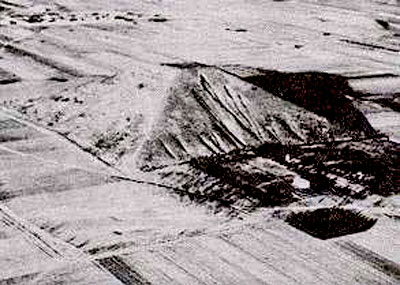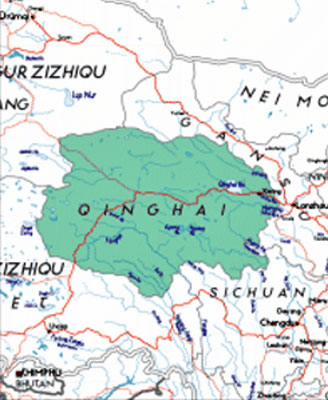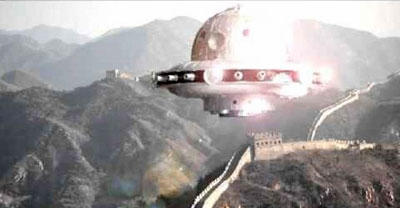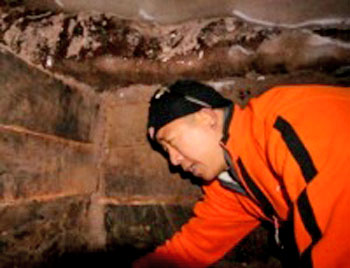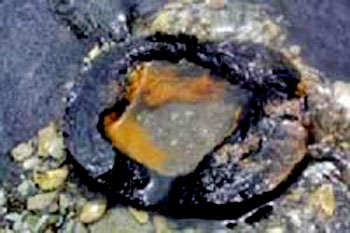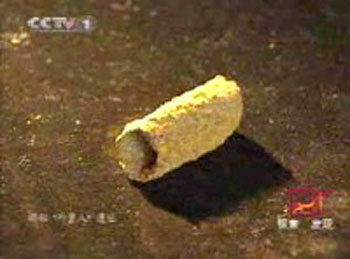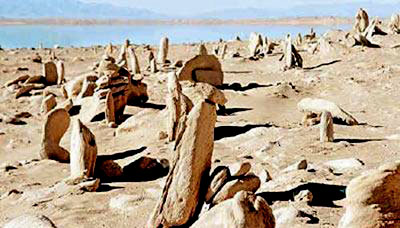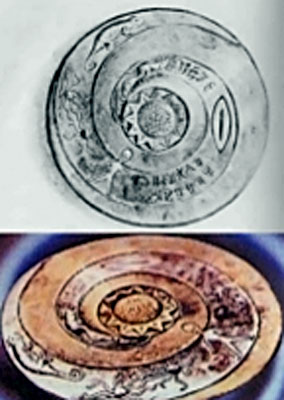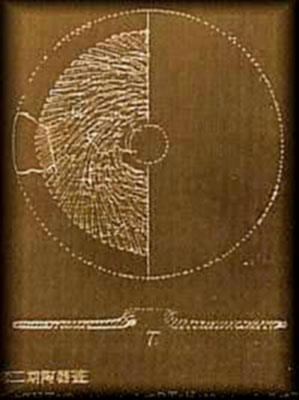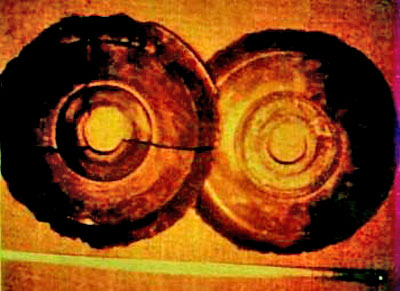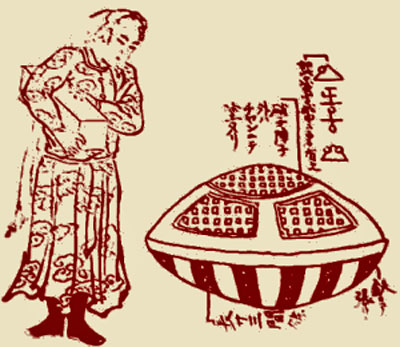Nine university scientists gaped upwards
at the gigantic, prehistoric pyramid that had no right to
exist
A team of
daring Chinese researchers, digging into the ancient mysteries of the origin of
their country, have come to the inescapable conclusion that 12,000 years ago, an
interstellar supreme alien race used much of the northern and central Chinese
regions as massive Earth bases.
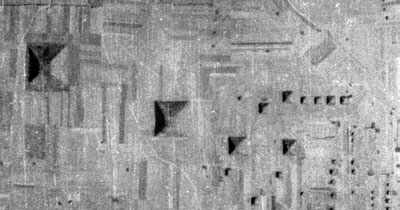
Hundreds of strange
pyramids cover parts of China
One such
base may be the astonishing pyramid structure that sits near the apex of Mount
Baigong in the western province of Qinghai, the Xianyang pyramid.
China is
the focus of legends, myths and stories of alien visitations and many of them
center on the Xianyang pyramid.
Local villagers claim their distant
ancestors spoke of sky great ships that navigated the heavens and used the
pyramid as a landing, refueling and resupply site.
ET origins investigated
The
hypothesis regarding extra-terrestrials is,
"understandable and worth looking into, [but] scientific means must
be employed to prove whether or not it is true,” Yang Ji, one of the scientists
and a researcher at the Chinese Academy of Social Sciences explained to
reporters.
While the
scientific exploration team agrees, all indications are that aliens used the
giant structure as one of its primary Earth bases.
Top is flattened - to accommodate landing ships?
The
anomalous pyramid rises almost 200 feet above the countryside - the surrounding
area littered with mystifying pipes, bizarre artifacts and unworldly odds and
ends.
China’s state-run Xinhua agency sent a nine man team to investigate
the pyramid and report back on their findings.
The team discovered pipes running from the caves and deep into the ground
slanting down into the earth… towards what?
Scientific team discovered numerous odd artifacts
The
agency tersely says:
“The
pyramid has three caves with openings shaped like triangles on its façade and is
filled with red-hued pipes leading into the mountain and a nearby salt water
lake.”
Above the
caves are dozens of pipes - all of various diameters - that mysteriously run
into the mountainside beneath the towering pyramid. All the pipes match the
color of the surrounding rocks, a murky reddish-brown.
Broken pipe goes deep into ground to...?
Elsewhere, more pipes, many lying shattered are scattered littering
the ground in every direction.
Some of
the pipes follow the bank of a salty lake while others dip into the water and
plunge beneath the lake bed.
One of the 'alien' artifact pipe fragments
Although
the pipes' purpose is officially classified as unknown, some of the Chinese
scientists are leaning towards the idea that the structure truly is the remains
of some advanced outpost or star-base.
The pyramid complex stretches out
much farther than what is visible and evidence suggests a highly technological
network of pressurized pipes supplying water and possibly fuels.
Strange artifacts litter the pyramid site
Since the
ancient site dates from at least 10,000 BCE - and is perhaps twice as old
as that - no humans could have engineered it as no serious human culture existed
that long ago.
Qin Jianwen, the head of the publicity department
of the Delingha government, says fragments of some of the pipe material were
taken for analysis.
The
pieces were found to be mostly silicon dioxide and calcium oxide, although more
than eight percent of the metal could not be identified.
"The
large content of silicon dioxide and calcium oxide is a result of long
interaction between iron and sandstone, which means the pipes must be very old,"
Liu Shaolin an engineer who did the analysis explained.
How old?
Some are guessing 12,000 years… maybe much, much older.
Enigma wrapped in
a mystery
That such structures exist
fits neatly into the unofficial history of China - a history most scholars
choose to ignore.
Some historians have called the early Chinese culture
an "enigma wrapped in a mystery."
Tales of China's ancient days are
crammed with stories about the "sky people" and the "god-men" who came from the
stars using the Earth as a base for exploration. Along the way these beings
taught some of the primitive peoples they met the basics of technology,
engineering, farming, and the complex structure of the universe.
In the
early years of the Twentieth Century two merchants from Australia crossed
central China. Upon the vast plains they found more than 100 pyramids. Locals
told the two men that the pyramids were very old - some much older than
China.
Other younger pyramids dated to the reigns of the oldest emperors.
Those
rulers often spoke of extraterrestrials and civilizations on other planets like
Earth. Some of the emperors even wrote that they were the progeny,
“of the
sons of the sky, who had landed upon Earth in iron
dragons.”
The
"skymen" - some still claim - built the oldest pyramids.
Astonishing
'Dropa stones' may provide clue to Chinese alien bases
Translation from the one of the 12,000-year-old Dropa
stones:
"The
Dropas came down from the clouds in their aircraft. The men, women and children
of the neighboring peoples (Ham) hid in the caves ten times before sunrise.
When at
last they understood the sign language of the Dropas, they realized that the
newcomers had peaceful intentions..."
[Translated from the language on the stones by the man who
successfully deciphered them, Dr. Tsum Um Nui.]
The great
Xianyang
pyramid is only one of many mystery sites pointing to one or more
advanced races interacting with the primitive peoples of Earth.
The
famous Dropa stones also provide strong evidence for extended Earth visits from
ancient astronauts.
The stones were found by Chi Pu Tei who led an
archeological expedition to the bleak and windswept Baian-Kara-Ula mountain
range in 1938. The range sits on the Chinese-Tibetan border and is home to many
stories about ancient extraterrestrials mingling with Earth people.
While
exploring a series of almost inaccessible mountain caverns last inhabited by
crude primitives thousands of years in the past, the scientific team made an
exciting discovery: some of the cavern walls were covered with pictograms
depicting scenes of the Solar System.
What's more, somehow these ancient
people had created a map of the heavens illustrating the Earth, sun, Moon and
various stars connected with intersecting lines and dots.
Curiously the
pictogram-maps almost resemble ancient trade routes or a guide for
explorers.
Other pictograms illustrate frail beings with round
helmet-like bowls on their heads.

One of the more than 700 Dropa discs found
But the
team's excitement was just beginning.
In one of
the caves with the murals of the heavens they found a stone disc half-buried in
the dirt.
The disc
had a thin spiral groove expertly cut into its face running from the center to
the edge. The disc they found measures about nine inches in diameter and roughly
three-quarters of an inch thick. The center has a perfect hole that's
three-quarters of an inch across.
Once they found the disc, Tei
instructed his team to hunt for more. Eventually they dug up a veritable
treasure trove.
A total
of 716 discs were found, some in pristine condition, others cracked or broken
into pieces.
Upon
later inspection, mysterious hieroglyphic symbols were found carved inside the
grooves. Obviously the disc contained a mother lode of information of some
kind.
Two of the discs Dr. Tsum Um Nui deciphered
Unfortunately, despite their potential importance, the discs
languished for years in packing crates.
They were
buried and forgotten in the dusty storage area of a museum until Dr. Tsum Um
Nui copied the writing from each of the surviving discs to
paper.
Dr. Nui succeeds
in deciphering 'Dropa stones'
The
unknown hieroglyphs were so miniscule he could only read them with the aid of a
powerful magnifier.
An expert at deciphering ancient languages, Nui
worked diligently for many months to crack the language. Finally, he succeeded.
What he learned would change the known history of the world, if anyone listened.
Few did.
The stones recorded an amazing story written at least 12,000
years ago by a fantastic people the world had forgotten.
The discs relate
the voyage of the
Dropa to Earth. How they crashed during their exploration of the
planet and became marooned on Earth, a foreign world unknown to them. Their
spacecraft was located in what later became known as the Baian-Kara-Ula
mountains, part of the Himalayas.
Stranded, the lost travelers sought
refuge in caves - the very caves Chi Pu Tei and his scientific exploration team
had discovered the discs.
"The
Dropas came down from the clouds in their aircraft," another disc said.
"The men,
women and children of the neighboring peoples (Ham) hid in the caves ten times
before sunrise. When at last they understood the sign language of the Dropas,
they realized that the newcomers had peaceful
intentions..."
Yet
another disc tells of the aliens having bulging heads and withered bodies. At
first the tribe sent hunters to kill the invaders until the people found the
strange beings meant no harm.
Villagers in the area still pass down the
legends about the visitors that,
"came
from the stars, long, long ago."
After
deciphering as many of the discs as he could, Nui wrote a paper about the
historic discovery for the Chinese Academy of Prehistory.
They refused to
publish it. Although well-documented and no question of it being fraudulent, the
editor of the journal told Nui that the world was not ready for such information
to be known.
The Chinese authorities under Mao were also quite explicit
in their reaction. They forbid the doctor from seeking to publish his paper
outside of China or even to speak of the Dropa stones.
Despite the order,
Nui did share the information with some close colleagues and eventually some of
the story managed to leak out to the rest of the world.
Russian
scientists join Dropa investigation
The Los Angeles Herald-Examiner published "Riddle of Asian Stone
Discs from Outer Space" on February 26, 1967:
|
February 26, 1967
Los Angeles Herald-Examiner reported the
following:
“Russian archaeologists are puzzling over a remarkable
collection of stone discs, thousands of years old, found in the mountains
bordering China and Tibet. So hard is it to explain them in terms of earthly
experience that the archaeologists do not rule out the possibility that the
discs may have come from outer space.
“A total of 716 discs, like Stone Age ‘gramophone
records’ have been picked up in recent years by men exploring caves in the
Bayan-Kara-Ula mountain range, reports the Soviet Union’s new English-language
magazine, Sputnik.
“Each disc has a central hole and irregular grooves
spiraling out to the edge, but the report says (quite seriously) that the groves
are not sound tracks. It is thought that they are some form of ancient writing,
but scientists have so far failed to decipher them.
“Chinese archaeologists estimate that the discs are
about 12,000 years old, but have made no headway at all in trying to explain
their purpose or how they came to be in the caves.
“The Russians, who have examined some of the discs in
a Moscow laboratory, claim to have made two important discoveries. One is that
the discs contain certain traces of metal - particularly cobalt.
“The second discovery, according to Vyacheslav
Zaitsev, author of the Sputnik report, is that the discs when scraped free of
rock particles ‘vibrate as if they carried an electric charge…’
“Zaitsev, who has spent 30 years collecting evidence
that intelligent beings from outer space have had contact with the earth,
believes that the discs may give substance to ancient Chinese legends of ‘small,
gaunt, yellow-faced men who came down from the clouds’ many centuries
ago.
“‘In some of the Bayan-Kara-Ula caves,’ he writes,
‘archaeologists and spelaeologists have found 12,000-year-old vestiges of graves
and skeletons. The remains belong to human beings with huge craniums and
underdeveloped skeletons.’
“‘The Chinese expeditions which discovered the burial
grounds reported that they had found an extinct species of ape,’ adds Zaitsev.
‘But so far as is known apes do not bury each other in graves or write
hieroglyphic symbols on stone
discs.’”
|
The
article focused on some Russian researchers who had been intently studying some
of the Dropa
stones.
"The
Russians," wrote the Herald-Examiner, "who have examined some of the discs in a
Moscow laboratory, claim to have made two important discoveries.
One is
that the discs contain certain traces of metal; particularly cobalt. Secondly,
when placed on a special turntable they hummed in an unusual rhythm like an
electrical charge was passing through them.
The Russian Zaitsev, who has
spent 30 years collecting evidence that intelligent beings from outer space have
had contact with the earth, believes that the discs may give substance to
ancient Chinese legends of small, gaunt, yellow-faced men who came down from the
clouds many centuries ago."
Incredible
Ancient Asian art depicts alien encounters
China's pre-history is rife with alien ships, alien beings and
alien goings-on.
An ancient Chinese relief depicts
an episode in the countryside when frightening "flying men"
terrorized herders.
Eerily,
the ancient artist recorded exactly what UFO investigators would record
today.
This is a reproduction of the stone relief found by a scientific
expedition of anthropologists during 1957 led by professor Tsj'i Pen-Lai.
The remarkable relief was discovered within an ancient maze on Jotuo island in
Lake Toengt'ing.
The
expedition took place in 1957.
Note what
appears to be a saucer-shaped object in the center and a being, resembling an
alien at the lower right.
Not all
aliens stay put in China
This old
Asian scroll from Japan depicts a Japanese merchant happening upon a small
flying saucer that's landed near a rice field.
Look carefully at the
writing above the craft.
The
column on the right is not Japanese, it's a representation of the symbols the
merchant saw on the craft and described to the artist who then added them to the
scroll for accuracy.
 Ellen Lloyd - MessageToEagle.com - They came from a distant place in our Galaxy. Their spaceship crashed on Earth.
Ellen Lloyd - MessageToEagle.com - They came from a distant place in our Galaxy. Their spaceship crashed on Earth.





